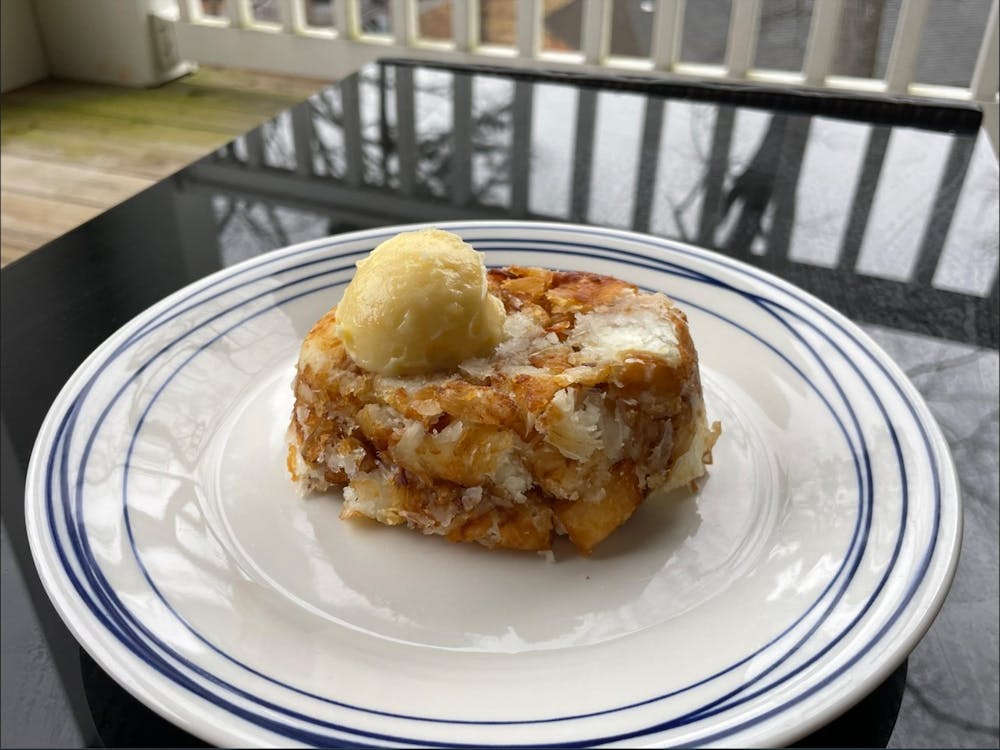Over winter break, my family went on a week-long trip to Puerto Rico — it was a culinary awakening like no other. As a person of mixed ethnicity with family ties to Cuba, Japan, Germany and Puerto Rico, I have struggled to fit in with any one group. Visiting Puerto Rico for the first time, I was immersed in a culture that was both new and familiar. From the rich history of Old San Juan and beautiful landscape of El Yunque National Forest to the hearty aroma of locally-made food, Puerto Rico captivated both my heart and my stomach.
Growing up, both of my parents cooked food from their cultures, so I learned about my heritage through taste. While I savored every bite of the many different foods I tried while in Puerto Rico, my favorite dish by far was yuca mofongo. Mofongo is a traditional Puerto Rican dish which consists of a starchy mash topped with a filling — usually pork, but often beef, chicken or vegetables.
Mofongo is traditionally made one of two ways — with green plantains or with yuca. Plantains are more thick and chewy in texture than yuca which is significantly more starchy and dry, so while both mofongo can be made with either ingredient, the final product is rather different.
Due to the recent impact of Hurricane Fiona in Puerto Rico this past fall, there has been a shortage of green plantains on the island, meaning many local restaurants carry only yuca mofongo for the moment. The first restaurant my family visited in Old San Juan was El Jibarito, which served a flaky and smooth mofongo de yuca far superior to the plantain mofongo I tried later in the trip on a different part of the island.
Before flying back to Virginia, I made sure to pick up a cookbook so that I could attempt to recreate some of the dishes I loved while in Puerto Rico. While this cookbook contains a recipe for mofongo de platanos, I was able to find a relatively straightforward recipe for mofongo de yuca online from Que Rica Vida. I halved the recipe and omitted the shrimp sauce and instead opted to serve with a thick garlic butter. Yuca may be more familiarly known as cassava and is often available at Lidl or in some local hispanic grocery stores.
Prep Time: 20 minutes
Cook Time: 40 minutes
Yields: 3 small mofongos
Ingredients
- 1.5 pounds yuca or cassava
- 2 minced garlic cloves
- 2 cups canola oil
- 2 tbsp unsalted butter
- Salt and pepper to taste
Instructions:
- Wash and dry yuca. Bring a large pot of salted water to boil.
- Peel yuca and chop into large chunks, then boil for 20 minutes or until tender.
- To make garlic butter sauce, mince one clove of garlic and add to 2 tbsp softened butter and stir until combined. Add salt and pepper to taste if desired.
- Drain yuca and slice into cubes about 1 inch thick. It is easiest to remove the yuca’s stringy inner core at this step.
- Heat canola oil in a medium pot to reach about 375 degrees Fahrenheit.
- Fry yuca in small batches until golden brown, about 2 minutes. Place on a paper towel-coated plate to drain and cool slightly.
- Place yuca in a mortar with one clove of minced garlic and mash into the shape of the bowl. If you don’t have a mortar and pestle, a small or medium bowl will work.
- Tip the bowl of yuca out onto a plate gently to preserve the shape and sprinkle with salt to taste.
- Serve with garlic butter, or top with a filling or sauce of your choice.
If yuca mofongo served plain with garlic butter does not make your mouth water already, alternate toppings include pork or beef cooked in a pressure cooker. For a vegetarian option, roasted vegetables pair nicely with yuca mofongo. The addition of a sauce or spread is critical for reintroducing moisture to the yuca and balancing out the starch.
Additionally, you could truncate the recipe after frying the yuca. Comparable to the familiar french fry, fried yuca is far superior with its more starchy texture and nutty flavor. Fried yuca is available in some local restaurants, including at the Cuban-inspired Guajiros Miami Eatery right here in Charlottesville.
While my first try at this recipe did not yield an exact replica of the yuca mofongo I enjoyed while in Puerto Rico, it provided me more insight into the process through which this dish was made and further connected me to my culture. I am inspired to continue spending time in the kitchen with foods from my various cultural backgrounds and I hope that this article encourages you to delve deeper into your own culinary heritage.







